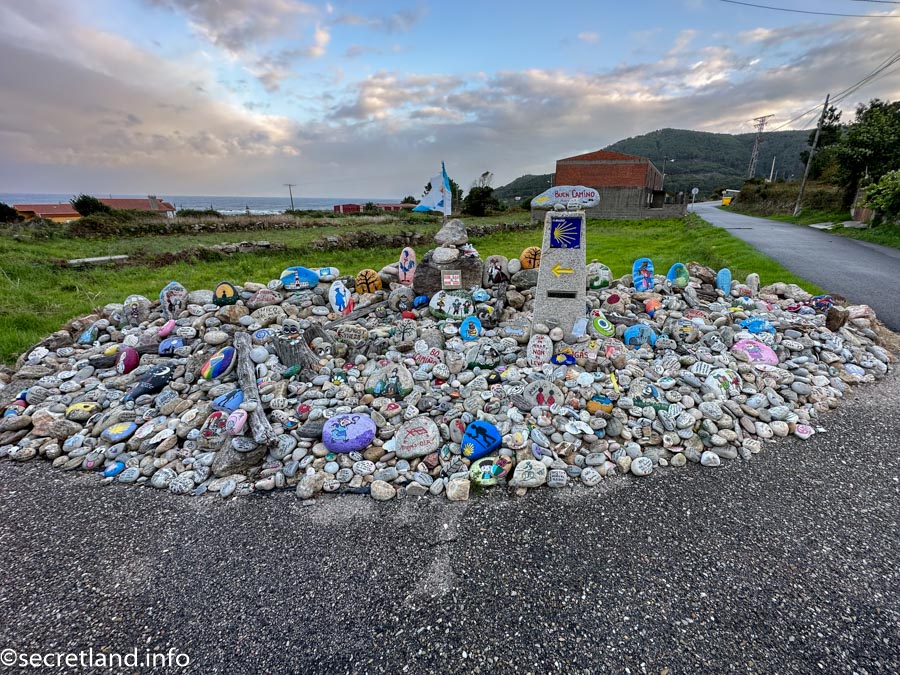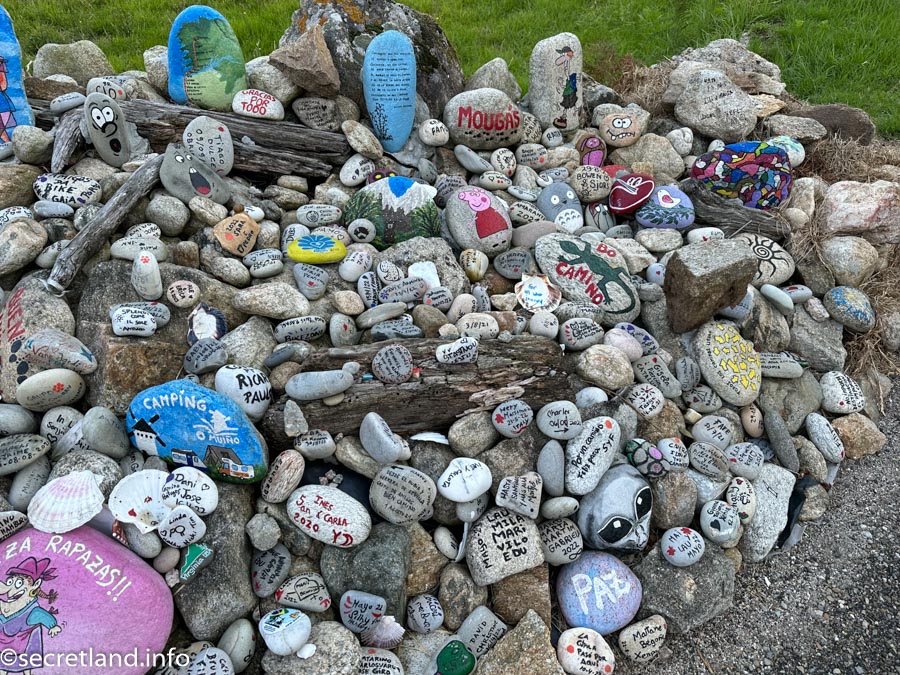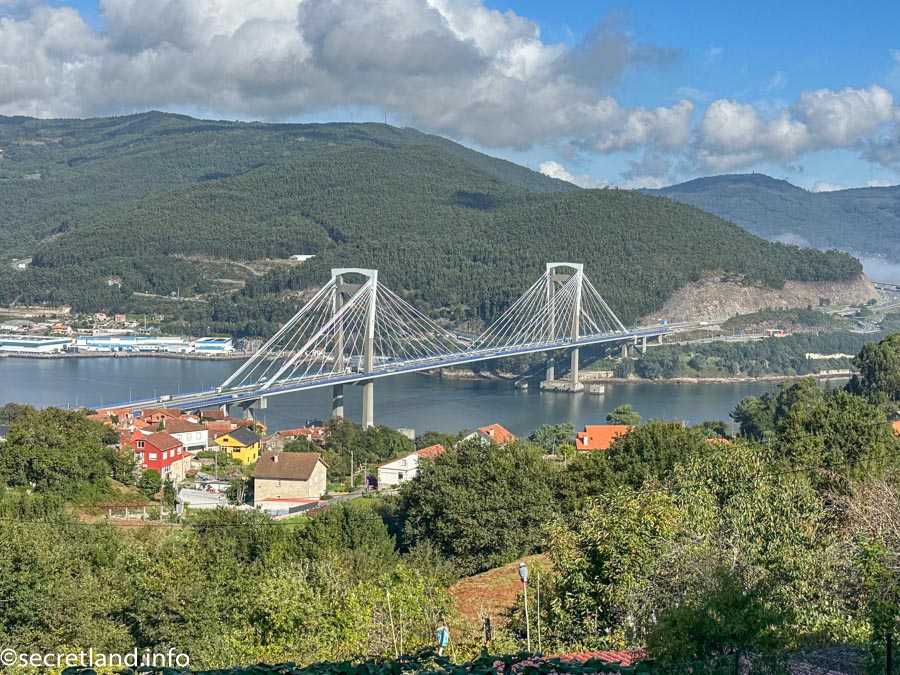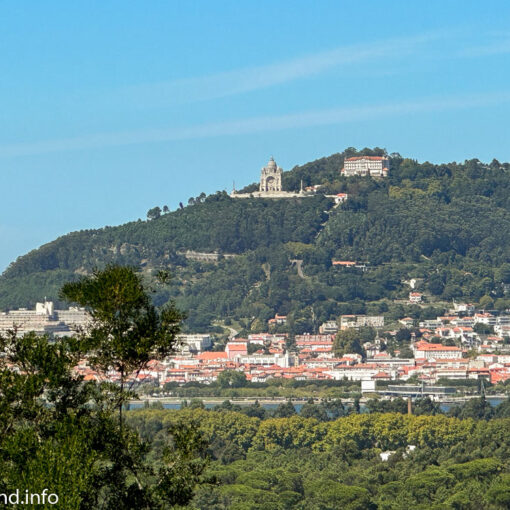On the seventh day of the Camino de Santiago from Porto, I had to walk 19 km from Villadesuso to the town of Nigrán. Rain was forecast for that day. I slept poorly during the night because a strong wind was blowing, and everything in the albergue was creaking and shaking. In the morning, it was gloomy, and the road was wet from the night’s downpour. Many pilgrims left the hostel early in the dark, and I was one of the last to leave. Fortunately, I hardly had any pain left anywhere.
The wind was very strong, making walking difficult, and from time to time, a light drizzle fell.
A final look at Alojamiento Camino Portugues Oia.

A narrow paved road winds gently between two low stone walls, leading towards green hills under a partly cloudy sky. On the left side, there is a grassy verge and a rural village with scattered houses and greenhouses. The scene feels calm and peaceful, typical of the countryside

This marker tells us that there are 143 km left to Santiago.

Soon, I came across a place like this — what should I call it, a pilgrim museum? On the map, this spot is marked as Hito de Mougas. Here, pilgrims have left numerous messages written and drawn on stones.

There are simple messages, and there are also very beautiful drawings

A collection of various stones decorated with colorful drawings, messages, and names left by pilgrims. The stones feature different designs, including cartoon characters, hearts, symbols of the Camino, and handwritten notes. This display is part of the Hito de Mougas, a unique spot where pilgrims leave their marks along the route

You could easily spend the whole day here just looking at these stones.

There are also messages from Ukraine

A colorful collection of painted stones with various messages and drawings left by pilgrims. Among them is a stone painted with a rainbow heart, symbolizing LGBTQ+ pride, and another with a yellow arrow pointing the way. Some stones feature hearts, cartoons, and written notes. The stones are arranged closely together with driftwood pieces on top

The path once again followed a trail lined with stone fences.

A rainbow appeared in the sky, and I hoped it was a good sign that there wouldn’t be any rain.

The ocean was rough today. A rocky coastline with waves crashing against the rocks under a cloudy, gray sky. Seabirds fly above the ocean, which appears rough and turbulent.

This windmill is located near Pedra Rubia.

Along the way, I came across a café, and many people took advantage of its hospitality to have coffee or fresh orange juice. Unfortunately, they didn’t accept cards, so I only got my stamp there. Back in Porto, I exchanged only 100 dollars for euros as a precaution, but it turned out that all the way to Vigo, there was nowhere else to exchange money.
The café is located on the campsite grounds https://www.campingmuino.com/camping/servicios/

The ocean continues to captivate with its beauty; it changes every day. Those who live by the ocean are truly fortunate.

The path followed the highway for a while, then the arrows pointed to the right. The men walking ahead continued along the highway, which bypasses Monte de Baredo and is a straight road without significant elevation changes. The women, however, took the Camino de Santiago path uphill.

On this map, you can see the blue path — that’s the Camino Portuguese Coastal route, which I took through the mountains. Alternatively, you can simply follow the highway along the ocean, as indicated by the bike route. The map is from https://en.mapy.cz/, which was the most helpful app for me on the journey.

And once again, I felt like a hobbit. The advantage of this path is that it’s less windy, unlike the road along the highway.

Wonderful views opened up from the hill

In some places, the road was paved with huge stones

The views are simply fantastic; it’s worth climbing up for this. You won’t see anything like this from the highway. A rocky hill covered with sparse vegetation overlooks a rough ocean under a cloudy sky. The coastline is visible in the distance, with waves crashing against the rocks. Power lines stretch across the sky above the scene.

A rocky trail with deep grooves worn into the stone, surrounded by patches of moss and grass. Pine trees and other greenery grow nearby, and the path leads into a forested area

Then the road led to the town of Cabreiro, to a pilgrim café that again accepted cash only. So, I just got my stamp there again. It’s called A Casa do Peixe

This tall building looks quite unusual among the low-rise houses.

Then heavy rain started, and I didn’t take any photos until I reached the town of Baiona. Sometimes the rain would stop and the sun would come out, giving me time to dry off, but then the rain would start again. All of this was accompanied by strong wind, and I was afraid of getting sick.
In the town of Baiona, the Camino de Santiago is marked by metal scallop shells embedded in the road.

The Camino de Santiago wound its way through the twisting streets of Baiona, and I wound along with it, while heavy, brief downpours alternated with bursts of bright sunshine. These constant detours tired me a bit, so I set a direct route to my hotel in Nigrán and followed the navigator along the ocean.
Numerous yachts and sailboats are anchored in a bay under a cloudy sky. The masts form a dense forest of lines, and the water is slightly rippled. A green shoreline with trees and buildings is visible in the background.


I arrived in Nigrán by taking the road along the ocean, while the Camino de Santiago bypasses the town from the east. After this photo, I didn’t take any more pictures all the way to the hotel because it started raining heavily again, and I arrived at the hotel completely soaked.

Today’s statistics

On the plus side, I didn’t have any pain that day; on the downside, there was rain and wind.
My adventures that day didn’t end there. First of all, I faced some translation difficulties with the hotel receptionist, who didn’t speak any English at all. And secondly, I had to complete a kind of quest — to manage to run 500 meters to the store while the sun was shining and get back before it started raining again. I only succeeded on my second attempt. On my first try, I left the hotel while the sun was out, but after just 50 meters, a heavy downpour started, and I was soaked to the skin in seconds. I had to go back, look for dry clothes, and try again.
I spent the evening with sandwiches and beer, watching my favorite series “Death in Paradise.” I found a channel that shows the series all Saturday long. The rain kept falling until night and continued throughout the night.
In general, a pilgrim’s day is divided into two parts — the journey itself and daily life at the place where you stay overnight. It’s great when the accommodation is in an interesting place with things to see. But on days like today, the pilgrim’s best friend is the television.
Spain
Hotels
- Hotel Atlántico Vigo
- Hotel Bruselas in A Guarda
- Hotel Scala, Padrón
- Hotel Holiday, Nigrán
- Martínez Rooms Pilgrims — apartments in Caldas de Reis
- A Boa Estrela Pension in Redondela
- Hotel Don Pepe, Poio
- Alojamiento Camino Portugues Oia, Villadesuso
- Rey Fernando Guesthouse in Santiago de Compostela
Cities
Camino
- How to walk the Way of Saint James
- Camino Portuguese – Day Five – Vila Praia de Âncora – A Guarda 14 km
- Camino Portuguese — Day Six — A Guarda — Villadesuso 18.8 km
- Camino Portuguese — Day Seven — Villadesuso to Nigrán, 19.5 km
- Camino Portuguese – Day Eight – Nigrán to Vigo, 22 km
- Camino Portuguese — Day Nine — Vigo — Redondela 15.7 km
- Camino Portuguese – Day Ten – Redondela – Pontevedra 21 km
- Camino Portuguese — Day Eleven — Pontevedra — Caldas de Reis 20 km
- Camino Portuguese – Day Twelve – Caldas de Reis to Padrón, 19.7 km
- Camino Portuguese – Day Thirteen – Padrón – Santiago de Compostela 22.5 km
Discover more from Secret land
Subscribe to get the latest posts sent to your email.



